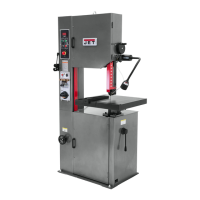Top Guide Adjustment
Always position the top guide to within an 1/8"of the
top surface of the workpiece. This minimizes
exposure of the operator's hands to the saw blade.
Changing Saw Blades
1. Disconnect saw from the power source.
2. Move the upper bladeguide to its highest
position and lock in place.
3. Open both wheel doors. Turn the tension
adjustment knob counter-clockwiseto loosen
tension on the blade.
4. Removethe blade from bothwheels and
maneuver it around the blade guard on the
column and protective shield on the upperblade
guide.
5. Install new blade by maneuveringaround blade
guard on the column and protective shield on the
upper blade guide.
6. Place it between the fingers of both blade guides
and onto both wheels. Position next to both
wheel flanges. Make sure teeth pointdown
toward the table.
7. Retentionthe saw blade by turning tension hand
wheel. Rotate the wheel by hand and make sure
the blade is properly seated in the bladeguides.
Blade guideswill have to be adjusted if the
replacement blade is a differenttype and width.
8. Turn on the saw and check bladetracking.
Adjust tracking if necessary.
Blade Selection
Proper blade selection is just as important to band
saw operation as is blade speed and material feed.
Proper blade selection will impact blade life,
straightness of cut, cut finish, and efficiency of
operation. Excess blade breakage, stripping of
teeth, and waviness of cut are some of the results of
improper blade selection.
Blades are classified by material composition, tooth
shape, pitch of teeth, and type of set, gage of the
band material, and kerf of the set (width of cut).

